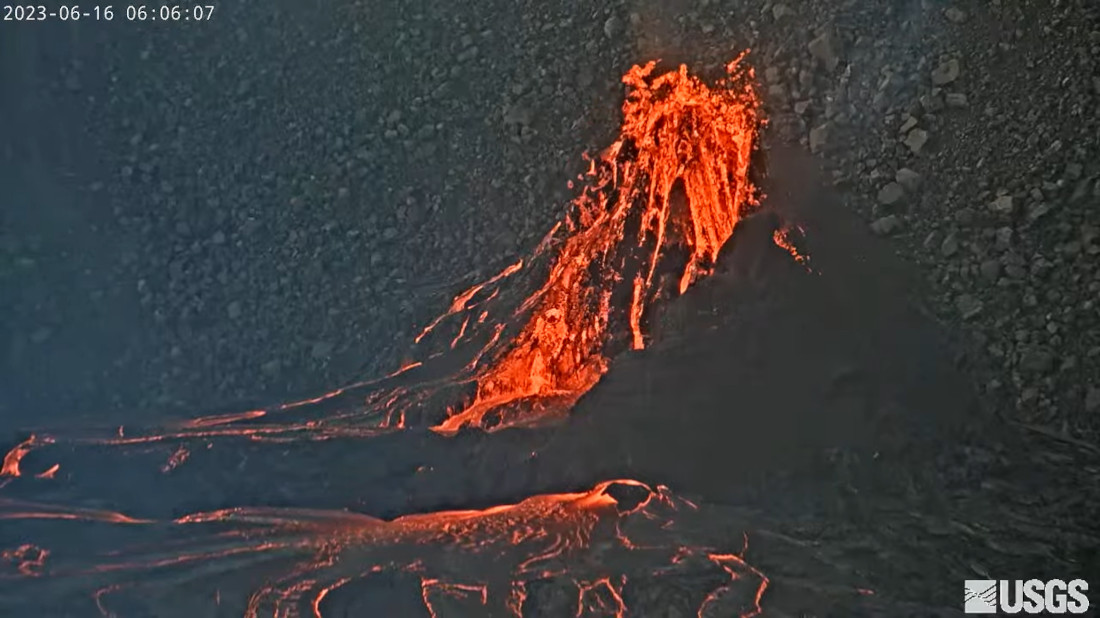(BIVN) – Kīlauea volcano is erupting, with all lava activity confined to the summit caldera within Hawaiʻi Volcanoes National Park. Over the past day, scientists noted renewed spattering from the eruptive vent in the southwest wall of Halemaʻumaʻu. As of Friday morning, the southwest wall vent was the only active eruptive vent at the summit.
From the USGS Hawaiian Volcano Observatory:
Halemaʻumaʻu Eruption Observations: The eruptive vent in the southwest wall of Halemaʻumaʻu continues effusing into the lava lake in the far southwestern portion of the crater. Around 8:00 a.m. yesterday morning, the very top of the spatter cone at this vent collapsed. Since then, spattering from the vent has been renewed and nearly constant, while several new lava streams have effused from the top of the cone in addition to the preexisting tube-fed flow from its base. This morning, a partial diversion in this flow from the base has been overflowing lava onto the southwestern-most block from the 2018 collapse within Halemaʻumaʻu. No other eruptive vents are active at this time.
The surface of the southwestern lava lake continues to circulate and is slowly rising, along with the rest of the crater floor, which is uplifting endogenously from lava accumulation below the solidified crust. Lava circulation also continues within the central basin that became the focus of effusion during both the 2021–2022 and January–March 2023 eruptions, although the lava level within it has been dropping relative to the surrounding crust. Several overflows from the southwestern lava lake even cascaded into the central basin last night and early this morning. No active lava has been observed in the northern or eastern portions of the crater over the past day. A live-stream video of the crater is available at youtube.com.
Summit Observations: Tiltmeters in the summit region have tracked slight deflationary tilt over the past day. Summit seismic activity is dominated by eruptive tremor—a signal resulting from fluid movement, and commonly associated with eruptive activity. Volcanic gas emissions in the area remain elevated; a sulfur dioxide (SO2) emission rate of approximately 4,800 tonnes per day was measured yesterday, Thursday, June 15.
Rift Zone Observations: No unusual activity has been noted along the East Rift Zone or Southwest Rift Zone; steady but low rates of ground deformation and seismicity continue along both. Measurements from continuous gas monitoring stations in the middle East Rift Zone—the site of 1983–2018 eruptive activity—remain below detection limits for SO2.
Hazard Analysis: The eruption at Kīlauea’s summit is occurring within a closed area of Hawai’i Volcanoes National Park. High levels of volcanic gas—primarily water vapor (H2O), carbon dioxide (CO2), and sulfur dioxide (SO2)—are the primary hazard of concern, as this hazard can have far-reaching effects down-wind. As SO2 is continuously released from the summit during the eruption, it will react in the atmosphere to create the visible haze known as vog (volcanic smog) downwind of Kīlauea. Vog information can be found at vog.ivhhn.org.
Additional hazards include Pele’s hair and other lightweight volcanic glass fragments from the lava fountains that will fall downwind of the fissure vents and dust the ground within a few hundred meters (yards) of the vent (s). Strong winds may waft lighter particles to greater distances. Residents and visitors should minimize exposure to these volcanic particles, which can cause skin and eye irritation.
Other significant hazards also remain around Kīlauea caldera from Halemaʻumaʻu crater wall instability, ground cracking, and rockfalls that can be enhanced by earthquakes within the area closed to the public. This underscores the extremely hazardous nature of Kīlauea caldera rim surrounding Halemaʻumaʻu crater, an area that has been closed to the public since late 2007.
The Hawaiian Volcano Observatory (HVO) continues to closely monitor Kīlauea volcano. HVO will continue to issue daily Kīlauea volcano updates until further notice. Additional messages will be issued as needed.


by Big Island Video News8:16 am
on at
STORY SUMMARY
HAWAIʻI VOLCANOES NATIONAL PARK, Hawaiʻi - There has been renewed spattering at the vent in the southwest wall of Halemaʻumaʻu over the past day, as the eruption of Kīlauea continues.